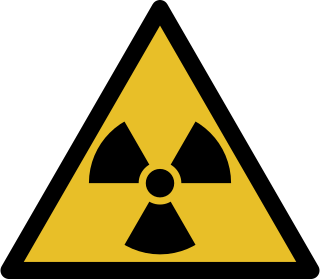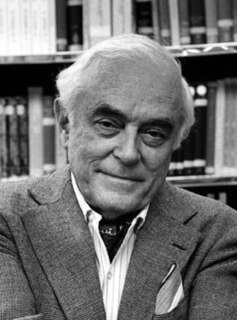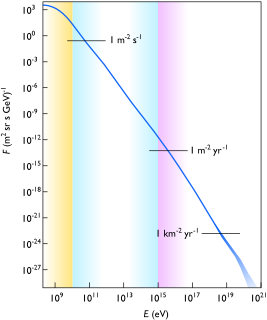
A neutrino is a fermion that interacts only via the weak subatomic force and gravity. The mass of the neutrino is much smaller than that of the other known elementary particles. Although only differences of squares of the three mass values are known as of 2016, cosmological observations imply that the sum of the three masses must be less than one millionth that of the electron. The neutrino is so named because it is electrically neutral and because its rest mass is so small (-ino) that it was long thought to be zero. The weak force has a very short range, the gravitational interaction is extremely weak, and neutrinos, as leptons, do not participate in the strong interaction. Thus, neutrinos typically pass through normal matter unimpeded and undetected.

Ionizing radiation is radiation that carries enough energy to detach electrons from atoms or molecules, thereby ionizing them. Ionizing radiation is made up of energetic subatomic particles, ions or atoms moving at high speeds, and electromagnetic waves on the high-energy end of the electromagnetic spectrum.

Neutrino astronomy is the branch of astronomy that observes astronomical objects with neutrino detectors in special observatories. Neutrinos are created as a result of certain types of radioactive decay, or nuclear reactions such as those that take place in the Sun, in nuclear reactors, or when cosmic rays hit atoms. Due to their weak interactions with matter, neutrinos offer a unique opportunity to observe processes that are inaccessible to optical telescopes.

Advanced Composition Explorer (ACE) is a NASA Explorers program Solar and space exploration mission to study matter comprising energetic particles from the solar wind, the interplanetary medium, and other sources.

The Haleakalā Observatory, also known as the Haleakalā High Altitude Observatory Site, is Hawaii's first astronomical research observatory. It is located on the island of Maui and is owned by the Institute for Astronomy of the University of Hawai'i, which operates some of the facilities on the site and leases portions to other organizations. Tenants include the Air Force Research Laboratory (AFRL) and the Las Cumbres Observatory Global Telescope Network (LCOGTN). At over 3,050 meters (10,010 ft) in altitude, the summit of Haleakalā is above one third of the Earths's troposphere and has excellent astronomical seeing conditions.

The Pierre Auger Observatory is an international cosmic ray observatory in Argentina designed to detect ultra-high-energy cosmic rays: sub-atomic particles traveling nearly at the speed of light and each with energies beyond 1018 eV. In Earth's atmosphere such particles interact with air nuclei and produce various other particles. These effect particles (called an "air shower") can be detected and measured. But since these high energy particles have an estimated arrival rate of just 1 per km2 per century, the Auger Observatory has created a detection area of 3,000 km2 (1,200 sq mi)—the size of Rhode Island, or Luxembourg—in order to record a large number of these events. It is located in the western Mendoza Province, Argentina, near the Andes.

PAMELA was a cosmic ray research module attached to an Earth orbiting satellite. PAMELA was launched on 15 June 2006 and was the first satellite-based experiment dedicated to the detection of cosmic rays, with a particular focus on their antimatter component, in the form of positrons and antiprotons. Other objectives included long-term monitoring of the solar modulation of cosmic rays, measurements of energetic particles from the Sun, high-energy particles in Earth's magnetosphere and Jovian electrons. It was also hoped that it may detect evidence of dark matter annihilation. PAMELA operations were terminated in 2016, as were the operations of the host-satellite Resurs-DK1.
A Forbush decrease is a rapid decrease in the observed galactic cosmic ray intensity following a coronal mass ejection (CME). It occurs due to the magnetic field of the plasma solar wind sweeping some of the galactic cosmic rays away from Earth. The term Forbush decrease was named after the American physicist Scott E. Forbush, who studied cosmic rays in the 1930s and 1940s.
The Russian Space Research Institute is the leading organization of the Russian Academy of Sciences on space exploration to benefit fundamental science. It was formerly known as the Space Research Institute of the USSR Academy of Sciences.

The GRAPES-3 experiment located at Ooty in India started as a collaboration of the Indian Tata Institute of Fundamental Research and the Japanese Osaka City University, and now also includes the Japanese Nagoya Women's University.
Martin Arthur Pomerantz was an American physicist who served as Director of the Bartol Research Institute and who had been a leader in developing Antarctic astronomy. When the astronomical observatory at the United States Amundsen–Scott South Pole Station was opened in 1995, it was named the Martin A. Pomerantz Observatory (MAPO) in his honor. Pomerantz published his scientific autobiography, Astronomy on Ice, in 2004.
Spaceship Earth may refer to:

The Advanced Thin Ionization Calorimeter (ATIC) is a balloon-borne instrument flying in the stratosphere over Antarctica to measure the energy and composition of cosmic rays. ATIC was launched from McMurdo Station for the first time in December 2000 and has since completed three successful flights out of four.
A strangelet is a hypothetical particle consisting of a bound state of roughly equal numbers of up, down, and strange quarks. An equivalent description is that a strangelet is a small fragment of strange matter, small enough to be considered a particle. The size of an object composed of strange matter could, theoretically, range from a few femtometers across to arbitrarily large. Once the size becomes macroscopic, such an object is usually called a strange star. The term "strangelet" originates with Edward Farhi and R. L. Jaffe. Strangelets have been suggested as a dark matter candidate.

John Alexander Simpson worked as an experimental nuclear, and cosmic ray physicist who was deeply committed to educating the public and political leaders about science and its implications, most notably as a principal founder of the Bulletin of the Atomic Scientists and a long-time member of the organizations Board of Sponsors. The year he died, his instruments in space had been sending data back for nearly 40 years. Simpson spent his career as an instructor and researcher for the University of Chicago's Enrico Fermi Institute and Department of Physics. His research continued up until a few weeks prior to his death on August 31 of 2000.
Wilson Marcy Powell was an American physicist and a member of the Physics department at the University of California, Berkeley.

Ashot Chilingarian is an Armenian physicist known for his contributions to the fields of high-energy astrophysics, space weather, and high-energy atmospheric physics. He is the head of the Cosmic Ray Division (CRD) and the director of the Alikhanyan Physics Institute in Armenia.















